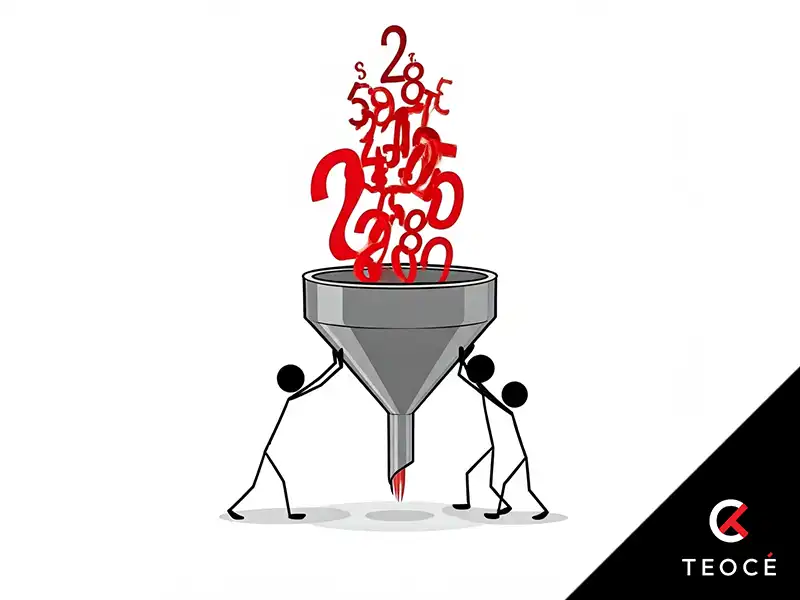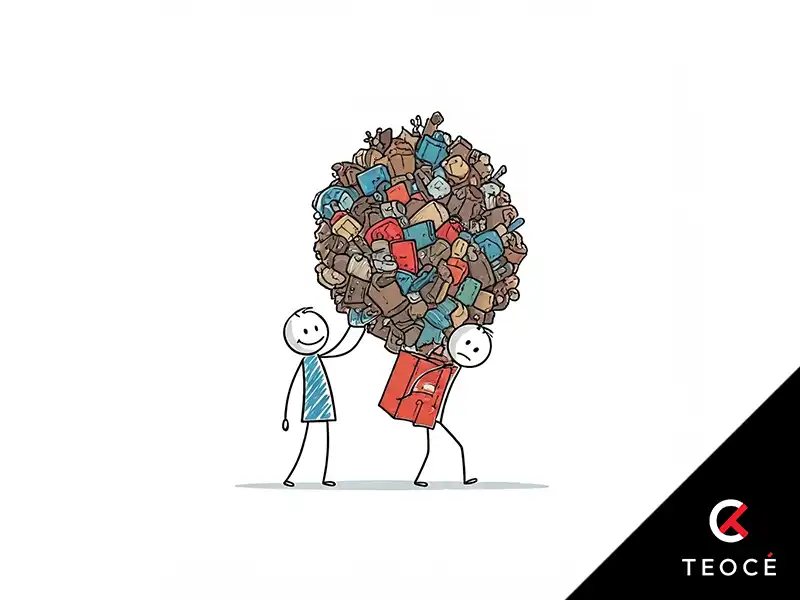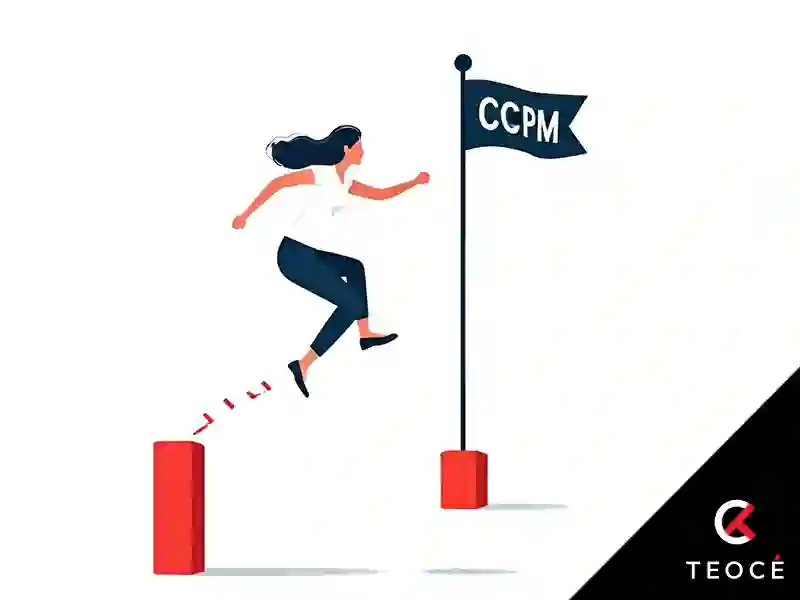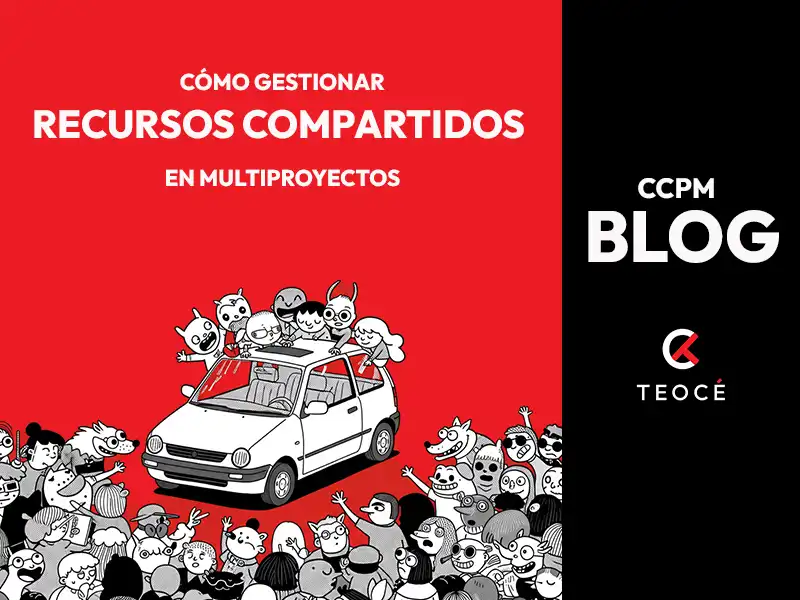Table of Contents
- Introduction: The real bottleneck is not projects, it is resources.
- CCPM and the Theory of Constraints: the basis of the approach
- Step 1: Identify the limiting resource (Pacing Resource)
- Step 2: Planning from the limiting resource
- Step 3: Eliminate multitasking, encourage focus
- Step 4: Subordinate the rest of the system
- Step 5: Raise capacity and continuous improvement
- CCPM tools for managing shared resources in projects
- Tangible benefits of managing shared resources with CCPM
- What's next? Take the next step to transform your operation
- Useful resources
Introduction: The real bottleneck is not projects, it is resources.
In multi-project environments, the real problem is not the projects, but the competition for limited shared resources. This situation leads to multitasking, lack of focus and constant delays.

Managing shared resources in projects requires changing the way work is organized. CCPM, based on the Theory of Constraints (TOC), proposes a different approach: managing from the constraint, which is almost always a key resource. This change of perspective allows decisions to be made based on the real capacity of the system, not on idealized schedules.
CCPM and the Theory of Constraints: the basis of the approach
To manage shared resources in projects effectively, you must first understand how a constraint operates in the system.
TOC asserts that every system has a single constraint. In projects, that constraint is rarely a task: it is almost always a shared resource whose availability conditions the rate of progress.
CCPM identifies that constraint and turns it into the system's control point: the Resource Pacing. At its pace, the rest is planned.
Unlike traditional methods, which protect each task and encourage multitasking, CCPM consolidates uncertainty into global buffers. This allows you to eliminate hidden margins and approach the job as a relay race: a task done right and delivered as soon as possible.
The result is a system that flows better, with less congestion and greater predictability.
CCPM is a system that allows us to learn. It allows us to identify the reasons for buffer consumption, it allows us to identify the lack of resources.
Xavier Tusquets in "The Great Challenge: Managing Projects in Uncertain Environments".
Next, we will analyze the steps to follow for the management of shared resources in multiprojects:
Step 1: Identify the limiting resource (Pacing Resource)

The first concrete action to manage shared resources in CCPM projects is to identify the constraint. This usually manifests itself as the most loaded resource, also called Pacing Resource or "Herbie".
This resource is key because it sets the pace of production. It is often difficult to scale, expensive and critical to the success of the project.
Detecting it involves observing resource saturation and visible signs such as the accumulation of work in progress in front of that point. Specialized software tools can facilitate this identification.
The metaphor of "Herbie", taken from Eli Goldratt's The Goal, illustrates it well: if the slowest person goes ahead and adjusts the pace of the group to his pace, the whole group moves forward with greater coherence.
Therefore, recognizing the Pacing Resource is the first essential step in coordinating multiple projects without collapsing the operation.
Step 2: Planning from the limiting resource
Once the Constraining Resource has been identified, the next step is to plan the system around it. In CCPM, this resource becomes the "drum" that sets the pace for all projects: its availability defines when and how tasks should be executed.
- Strategically prioritize projects: define what is delivered first and why, based on criteria such as economic impact, commercial commitments or internal needs.
- Schedule the tasks of the Pacing Resource first: organize your workload respecting the established order of priority. This sequence will define the system schedule.
- Insert Capacity Buffers: add time margins between tasks of the Pacing Resource that belong to different projects. Their function is to absorb variability and protect the pace of the critical resource.
- Subordinate the rest of the system: plan the other tasks following the "as late as possible" (ALAP) approach, to feed the Pacing Resource just in time and avoid unnecessary backlogs.
This mechanism allows:
- Balancing the system load
- Reducing resource conflicts
- Minimize work in progress
In addition, by eliminating multitasking and promoting single-task focus, quality is improved and delivery is accelerated. Thus, the system moves forward synchronously, like a relay race: clear, fast and coordinated.
Step 3: Eliminate multitasking, encourage focus

Multitasking is the number one enemy of productivity. It generates stress, lowers the quality of work and lengthens deadlines unnecessarily. Trying to make progress on several tasks at once only multiplies the effort, without improving the result.
It has been proven that humans are not efficient in the constant change of context. As reported in the book "The Grand Challenge: Managing Projects in Uncertain Environments", a simple simulation reflects this: copying two data tables alternating between them, instead of completing one first and then another, increased total time by 30 percent. a simple simulation reflects this: copying two data tables alternating between them, instead of completing one first and then the other, increased the total time by 30% and significantly delayed the delivery of the first part.
CCPM proposes a straightforward solution: moving from managing schedules to managing the flow of the system. Instead of adding individual protection to each task, uncertainty is concentrated in global buffers, protecting the project as a whole.
The project as a whole must be protected, not each individual task.
Xavier Tusquets in "The Great Challenge: Managing Projects in Uncertain Environments".
This allows:
- Focusing on one task at a time
- Complete tasks as quickly as possible
- Deliver immediately to the following resource
As in a relay race, the important thing is not to run all at the same time, but to pass the baton without interruptions.
The result: less conflict, less operational burden, more visibility and greater control over the actual progress of the project.
Step 4: Subordinate the rest of the system
Once the rate of the Constraining Resource is set, CCPM establishes an essential rule: the entire system must be subordinated to its availability. This ensures synchronization between projects that share resources and avoids conflicts that arise when planning in parallel without shared visibility.
This subordination is materialized in two key elements:
- Use of buffers instead of hidden marginsInstead of protecting each task separately, CCPM consolidates uncertainty into three types of buffers:
- Project Buffer: protects the final delivery date.
- Feed Buffers: protect the critical chain against tasks converging from other routes.
- Resource Buffers: guarantee the availability of key resources at critical points.
- Visual control through buffer consumptionMonitoring buffer usage, e.g. with the Fever Chart, makes it possible to detect risks of deviation before they materialize.
- If the buffer is not consumed, no action is taken.
- If it enters the yellow zone, it is planned.
- If it reaches red, action is taken.
This control system simplifies decision making, avoids unnecessary interventions and concentrates efforts on the tasks that really affect the flow of the project.
Thus, subordination is not rigidity, but intelligent coordination: the system is protected without overloading it, focus is gained, and multitasking is reduced at the root.
Step 5: Raise capacity and continuous improvement

Once the system has been subordinated to the Pacing Resource and its capacity has been exploited to the maximum, the next step is to evaluate whether that resource is still the main constraint.
If it is no longer, the process returns to Step 1: identify the new emerging constraint.
This continuous cycle prevents inertia from becoming a new constraint. In CCPM, there is always a constraint, and managing it correctly is what guarantees system performance.
However, increasing capacity does not imply oversizing the system. The organization must consciously decide where it wants its constraint to reside: a resource that is difficult to expand, costly and of high strategic value.
Oversizing all resources leads to a more expensive and inefficient company. On the other hand, choosing the right point of constraint allows you to maintain focus, scale judiciously and protect profitability.
This iterative approach also allows learning from experience. CCPM is not a static system. As environments, resources or durations change, schedules, buffers and decisions are adjusted.
Continuous monitoring of the system (especially buffer consumption) helps to detect patterns, anticipate problems and act in advance.
In short, selectively raising capacity and learning in each cycle is what makes CCPM a continuous improvement tool and not just a planning method.
CCPM tools for managing shared resources in projects
The effective management of shared resources in CCPM projects is enhanced with specialized software tools, although it is not always mandatory to adopt new solutions. These tools are key to visualize, prioritize and synchronize tasks in complex multi-project environments.
Among its main functionalities, the following stand out:
- Visualization of resource loading, especially Resource Pacing.
- Sizing and placement of buffers (project, power and resource).
- Automatic prioritization and dynamic adjustment of tasks according to the impact on the flow.
One of the most relevant tools is the Fever Chart, which graphically shows the progress versus consumption of the Project Buffer. This visualization makes it possible to identify deviations in time, prioritize critical tasks and keep the focus on what really affects the project.
The software constantly recalculates the Critical Chain and generates prioritized lists. This reduces multitasking and makes it easier for each resource to work with focus, following the logic of passing the baton.
Multitasking is the number one enemy of productivity
Xavier Tusquets in "The Great Challenge: Managing Projects in Uncertain Environments".
Examples of CCPM tools
- Fusion Online from ProChain Solutions: global reference in CCPM software, stands out for its robustness, synchronization capacity and scalability. It is the one we have been using at TEOCÉ for years. It enables a precise and clear implementation and management of projects.
- BeingManagement3: comprehensive platform with complete focus on CCPM.
- Microsoft Project: although not specifically designed for CCPM, it can be used for basic tasks with adaptations.
- Jira: common in agile management, but requires plugins or data replication to work with CCPM logic, as it does not handle buffers or subordinate sequences natively.
These tools do not replace the mindset change, but they greatly facilitate it. They help translate CCPM logic into daily operational actions, maintaining visibility and control without bureaucratic overload.
Tangible benefits of managing shared resources with CCPM
Managing shared resources with CCPM generates operational and strategic benefits that directly impact efficiency, quality of work life and profitability.
Significant reduction in delivery times
Subordinate planning and the focus on flow make it possible to shorten project cycles by 20-50%. Tasks are completed faster, projects flow without blockages and the company becomes a more reliable supplier, able to meet demanding deadlines and even improve its commercial positioning.
2. Reduction of operational stress
By eliminating multitasking and prioritizing what really matters, teams work with more clarity and less pressure. This translates into a better work environment, less turnover and more focus. People regain the ability to concentrate without constant interruptions.
Increased collaboration and visibility
The logic of subordination to Resource Pacing and the use of tools such as the Fever Chart favor coordination between areas. Everyone sees the real status of the projects and aligns according to progress and buffer consumption. This reduces friction and improves shared decision making.
4. Strategic impact on the operation
CCPM does not optimize individual resources, but the system as a whole. By increasing the capacity of the constraint, the overall production capacity is increased without multiplying resources. This generates higher turnover, better use of assets and higher return on investment.
These benefits make CCPM a tool for deep transformation, not just point improvement. It is a new way of operating that changes how decisions are made, planned and value is delivered in multi-project environments.
What's next? Take the next step to transform your operation

If you are managing multiple projects with shared resources and feel that chaos and delays have become normal, it's time to take a different approach.
At Teocé we have been helping organizations to implement CCPM with measurable results in terms of deadlines, focus and profitability.
- Discover how to apply it in your environment with our online CCPM course.
- Delve deeper with real-world examples and key concepts in the book The Big Challenge: Managing Projects in Uncertain Environments.
- Or request a strategy a strategy session with our team to assess your situation and see how to take the first step.
👉 Enter teoce.com and find the resource that best suits your case.
Managing shared resources in projects no longer has to be chaotic. With CCPM, you can turn it into your competitive advantage.
Useful resources
For further information on what has been explained in this article, we recommend:
- Tusquets, Xavier (2021). El Gran Reto: Gestionar proyectos en entornos inciertos.
- Goldratt, Eliyahu M. (1993). The Goal.
- Goldratt, Eliyahu M. (2013). Critical chain.
- Newbold, Robert (2008). The billion dollar solution.
- Trietsch, D. (2006). "Optimal feeding buffers for projects or batch supply chains by an exact generalization of the newsvendor result." International Journal of Production Research, 44(4), 627-637230.
- Prochain Fusion Online Prochain Solutions software optimal for managing projects with CCPM.
